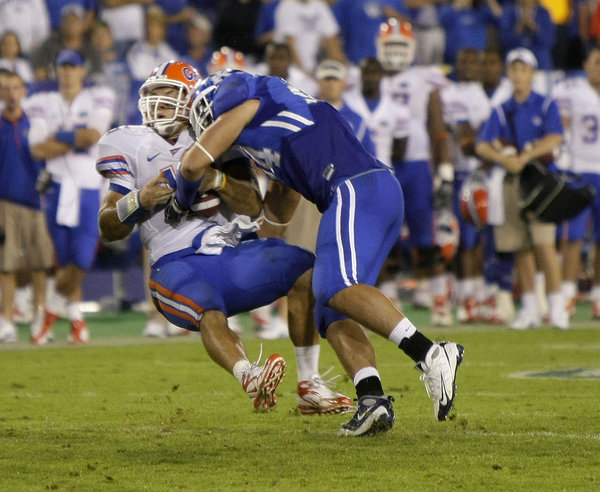INDIANAPOLIS, IN (February 12, 2007) -- In its continuing emphasis on illegal helmet-to-helmet contact in high school football such as spearing, the National Federation of State High School Associations (NFHS) Football Rules Committee reorganized and clarified several rules with the intention of further reducing the risk of head injuries, such, as concussions, in the sport.
Rules revisions regarding illegal helmet contact were among 14 rules revisions made by the committee at its January 20-21 meeting in Indianapolis. The rules changes were subsequently approved by the NFHS Board of Directors.
In Rule 2, the committee placed butt blocking, face tackling and spearing under the heading of "Helmet Contact -- Illegal" to place more emphasis on risk-minimization concerns. In Rule 9-4-3, the committee added a note that lists examples of some types of illegal helmet contact that could result in disqualification.
 Examples of illegal helmet
contact that could result in disqualification include, but are not
limited to: a) illegal helmet contact against an opponent lying on the
ground; b) illegal helmet contact against an opponent being held up by
other players; and c) illegal helmet-to-helmet contact against a
defenseless opponent.
Examples of illegal helmet
contact that could result in disqualification include, but are not
limited to: a) illegal helmet contact against an opponent lying on the
ground; b) illegal helmet contact against an opponent being held up by
other players; and c) illegal helmet-to-helmet contact against a
defenseless opponent.
In addition, the committee formulated a definition of a flagrant foul, an often-used term in the rules book but which previously was not specifically defined. A flagrant foul will be defined as a foul that may or may not involve physical contact, but involves such acts as fighting, contacting a game official, fouls so severe as to place an opponent at risk, persistent or extreme abusive conduct and the use of vulgar language or gestures.
"While these changes mostly involve reorganization, the committee is confident that the rules now place a stronger emphasis on flagrant acts and illegal helmet contact," said Bob Colgate, NFHS assistant director and liaison to the Football Rules Committee. "These revisions continue our ongoing emphasis on risk minimization and good sportsmanship."
"Annually, the NFHS Football Rules Committee has sought ways to better promote the health and physical welfare of the participants and cultivate the high ideals of good sportsmanship," said Brad Cashman, executive director of the Pennsylvania Interscholastic Athletic Association and chair of the NFHS Football Rules Committee. "The rules committee has again raised the standard in regard to both areas of concern."
Changes in the football game jersey specifications that were approved last year for implementation in 2010 were revised slightly this year, and the implementation date was moved back to 2012. The revised rule will still require the visiting team's game jerseys to be white and contrast with the home team's jersey.
"The changes made this year by the committee will provide manufacturers and schools a clearer direction on the specifications," Colgate said. "The committee extended the implementation date to give schools an opportunity to make the necessary adjustments during the normal uniform rotation and replacement cycles during the next five seasons."
In Rule 8-2-2, an enforcement option has been added when there is a foul by the opponent of a team scoring a touchdown. In addition to its previous option of accepting the result of the play and having the penalty enforced on the try-for-point, the scoring team may choose to have the foul enforced on the ensuing kickoff.
Two changes were made in Rule 1-2-3 regarding "The Field and Markings." A 4-inch-wide broken restraining line is now required around the outside of the field, and the line must be at least two yards from the sidelines and end lines. The only exception to this rule will be in stadiums where the total field enclosure does not permit the line. In addition, a line, 4 inches wide by 12 inches long, that bisects the limit line at each 5-yard line extended, may be used.
"These lines are used to assist line-to-gain crews, as well as providing additional safety features for players, officials and sideline media; helping game officials with an unobstructed sideline operating area; and providing coaches with an unobstructed view from the coaching box," Colgate said.








